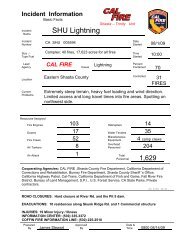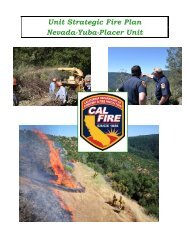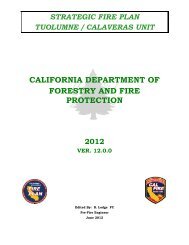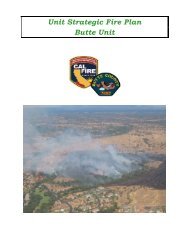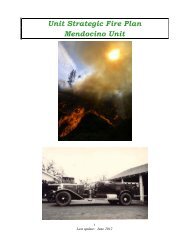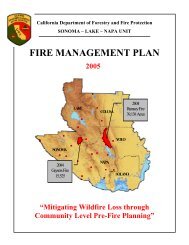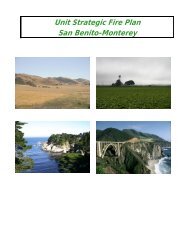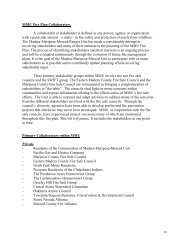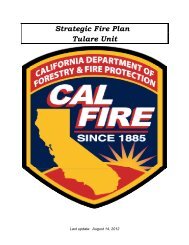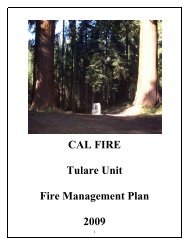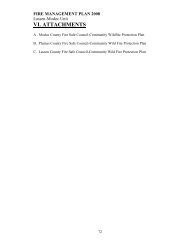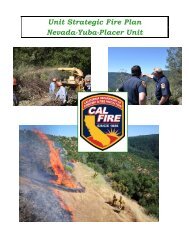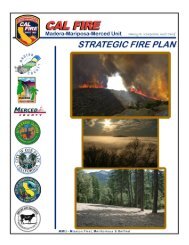Strategic Fire Plan San Diego Unit (MVU) - Board of Forestry and ...
Strategic Fire Plan San Diego Unit (MVU) - Board of Forestry and ...
Strategic Fire Plan San Diego Unit (MVU) - Board of Forestry and ...
You also want an ePaper? Increase the reach of your titles
YUMPU automatically turns print PDFs into web optimized ePapers that Google loves.
30-year period. One area is located south <strong>of</strong> the Interstate 8, west <strong>of</strong> Buckman Springs Road, north <strong>of</strong><br />
Highway 94 <strong>and</strong> east <strong>of</strong> Harbison Canyon. A second area that has not experienced fire is the area near<br />
Highway 79 <strong>and</strong> Highway 76, near the community <strong>of</strong> Warner Springs. The last area <strong>of</strong> concern is the<br />
northwest area <strong>of</strong> <strong>San</strong> <strong>Diego</strong>, which starts in the north near the Rainbow community <strong>and</strong> follows the<br />
Highway 15 corridor south to Bonsall community.<br />
Building St<strong>and</strong>ards – Title 7A, 19 <strong>and</strong> 24<br />
<strong>San</strong> <strong>Diego</strong> County has adopted Building Code Chapter 7A st<strong>and</strong>ards (Material <strong>and</strong> Construction Methods<br />
for Exterior Wildfire Exposure) <strong>and</strong> Chapter 47 st<strong>and</strong>ards (Requirements for Wildl<strong>and</strong>-Urban Interface<br />
Area). Additionally, <strong>San</strong> <strong>Diego</strong> County is certified as compliant with Title 14 - SRA <strong>Fire</strong> Safe Regulations<br />
<strong>and</strong> Public Resources Code 4290.<br />
Vegetation Management Projects <strong>and</strong> Environmental Review<br />
All proposed vegetation management projects (including fuels treatment activities) are subject to the<br />
California Environmental Quality Act <strong>and</strong> environmental review. The following is a brief listing <strong>of</strong> the key<br />
components related to project review:<br />
· Biological Resource <strong>and</strong> Multi-Species Conservation Program<br />
<strong>San</strong> <strong>Diego</strong> County is a “hot spot” area for unique <strong>and</strong> unusual species. With 28 species listed or<br />
proposed listed as threatened or endangered <strong>and</strong> an additional 57 species that are considered<br />
sensitive underscores the uniqueness <strong>of</strong> <strong>San</strong> <strong>Diego</strong> natural environmental. Given the richness <strong>of</strong><br />
species, <strong>San</strong> <strong>Diego</strong> County’s Multi-Species Conservation Program (MSCP) promotes the protection<br />
<strong>of</strong> these species, while balancing the need for use <strong>and</strong> development <strong>of</strong> property. To ensure<br />
protection for these species, both the California Department <strong>of</strong> Fish <strong>and</strong> Game <strong>and</strong> the US Fish <strong>and</strong><br />
Wildlife Service are consulted on all fuels treatment projects.<br />
· Archeology<br />
All CAL FIRE projects, such as VMP or fuels management projects, are reviewed by a qualified<br />
Department Archeologist, as required by the California Environmental Quality Act (CEQA 1970). As<br />
required, each project is evaluated to determine if the project will have any effect on a defined<br />
cultural resource. Department policy is to avoid adverse effects to significant cultural resources<br />
(prehistoric or historic resource consistent with CEQA), which is most <strong>of</strong>ten by avoidance. This<br />
internal practice began with the passage <strong>of</strong> the Forest Practice Act (FPA 1973). Since the passage<br />
<strong>of</strong> the FPA, archeologists regularly review projects <strong>and</strong> conduct archeological surveys. A number <strong>of</strong><br />
other laws play a part in the protection, preservation, <strong>and</strong> management <strong>of</strong> cultural resources in<br />
California. Also, CAL FIRE State Archeologists participate in the department’s response to wildl<strong>and</strong><br />
fires. They participate in SEAT ‘s (State Emergency Assessment Teams) when called in after a<br />
major fire to scientifically evaluate “values at risk” in the affected burned area as allowed under the<br />
former Governor’s Executive Order.<br />
· Water Quality <strong>Board</strong>s<br />
To meet the requirements <strong>of</strong> the Porter-Cologne Water Quality Control Act, all projects, including<br />
vegetation management projects, are reviewed for water quality impacts. Depending on the<br />
location <strong>of</strong> the project, the <strong>Unit</strong> will consult with the <strong>San</strong> <strong>Diego</strong> Regional Water Quality Control<br />
<strong>Board</strong> or the Colorado River Regional Water Quality Control <strong>Board</strong>.<br />
o Region 7 -- Colorado River Regional Water Quality Control <strong>Board</strong>: Orange, <strong>San</strong><br />
Bernardino, Riverside, <strong>San</strong> <strong>Diego</strong> counties.<br />
o Region 9 -- <strong>San</strong> <strong>Diego</strong> Regional Water Quality Control <strong>Board</strong>: <strong>San</strong> <strong>Diego</strong>, Orange,<br />
Riverside counties.<br />
· Greenhouse Gas Emissions <strong>and</strong> Air Quality<br />
All projects must consider greenhouse gas emission as part <strong>of</strong> the environmental review process.<br />
Nationally recognized protocols are used to estimate the total greenhouse gas emissions that will<br />
occur due to project activities. <strong>Unit</strong> projects are evaluated for air quality impacts <strong>and</strong> where<br />
8



